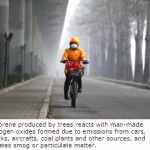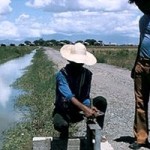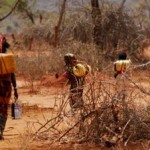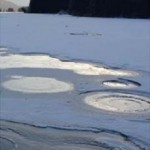- Lost Greenland ice, along with runoff to the ocean from permafrost thawing and melting of small glaciers, contributes to changes in global ocean circulation, with possible major consequences for weather systems globally.
 Climate change is a major stressor on Arctic biodiversity, with unique habitats disappearing and the life cycles of species synchronized to the melt of snow and ice disrupted.
Climate change is a major stressor on Arctic biodiversity, with unique habitats disappearing and the life cycles of species synchronized to the melt of snow and ice disrupted.- Arctic mammals such as polar bears, walruses and some seals are particularly vulnerable to the loss of summer sea ice as the ice serves as a launching point and resting area during hunting. For example, receding ice has led to increasing numbers of walruses congregating at a handful of locations on land far from their feeding grounds.
- While sea ice loss opens up opportunities for fishing for some of the Arctic’s approximate four million inhabitants, the loss of sea ice also means coastal communities have less protection from storms. Thawing permafrost destroys vital infrastructure, and changes to the Arctic can threaten indigenous communities’ traditional subsistence lifestyle.
The Way Forward for the Arctic
The report issued many recommendations to tackle the emerging issues, including:
- Reducing greenhouse gas emissions remains the most-important measure. Action within the UN climate process is essential and there may be scope for complementary action on curbing regional emissions of short-lived pollutants such as black carbon.
- No steps to exploit the new environmental state of the Arctic should be taken without first assessing how the exploitation would affect ecosystems, the peoples of the North and the rest of the world as the potential for major environmental damage is high.
- The challenges posed by climate change and social and economic development in the Arctic require a long-term vision and innovative policy responses. Assessing the options for the Arctic should explicitly include indigenous peoples and other stakeholders.
- The rapid pace of change means that strengthened systems for monitoring and providing early warnings of new developments are essential. In particular, environmental research is urgently needed on the impact of short-lived pollutants, the mechanisms of changes to snow and ice and their implications, present and future changes in the biosphere, and the use of traditional knowledge to inform policy and management actions.
Illegal Trade in Wildlife
Another key aspect of the report is the focus on the serious spike in the illegal trade in wildlife.
Data from the Convention on International Trade in Endangered Species (CITES) monitoring programme showed that 2011 had the highest level of poaching since records began in 2002. Early indications suggest that the number of elephants that were killed in 2012, ran, as in 2011, into the tens of thousands, while a record 668 rhinos were poached in South Africa that year.
Illegal killing of large numbers of elephants increasingly involves organized criminal groups and sometimes well-armed militias. For example, up to 450 elephants were killed in Cameroon in early 2012. Poached ivory is believed to be exchanged for money, weapons and ammunition to support conflicts in the region.
CITES and its partners are supporting the strengthening of national enforcement capacities to fight wildlife crime. UNEP and CITES are also launching a campaign aimed at reducing demand for products from the illegal wildlife trade.
Reaching the 2020 Goal for Sound Chemicals Management
The UNEP Year Book 2013 also highlights that while chemicals bring many benefits, there is a need for better information and coordinated action by governments and industry to reduce the growing risks to human health and the environment posed by the unsustainable management of chemicals worldwide.
 These risks may be compounded by the steady shift in the production, use and disposal of chemical products from developed countries to emerging and developing economies, says the report.
These risks may be compounded by the steady shift in the production, use and disposal of chemical products from developed countries to emerging and developing economies, says the report.
Annual sales of chemical products doubled between 2000 and 2009, with the share manufactured in highly industrialized countries falling from 77 to 63 per cent. Yet we are falling behind with pre-market testing and too little is known about chemicals already in circulation.
The number of man-made chemicals in the environment is increasing, with one 2009 study finding 212 chemicals in the blood and urine of a sample of the population of the United States. Of those chemicals, 75 had not been previously measured. Emerging challenges include the risks of chemical mixtures, low-dose exposure, the substitution of hazardous chemicals by other hazardous chemicals, and nanotechnology.
Costs associated with the risks of chemicals are difficult to assess. However, many studies support the urgency of risk minimization. For example, a recent study found that preventing exposure to the neurotoxin methyl mercury in children could save the European Union billions of Euros each year.
UNEP is heavily involved in reducing the risks from mercury, and in January 2013, the international community agreed a UNEP-facilitated global treaty on Mercury – the Minamata Convention – which will be open for signing in October.
The report recommended the use of economic instruments to create financial incentives for improving chemical safety, increased government capacity for chemical regulation and clear and consistent public information on the hazards and uses of specific chemicals.
Source: UNEP.








